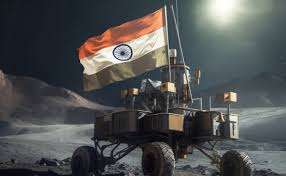
JAI HIND!!!
Congratulations INDIA!
The recent updates regarding Chandrayaan-3, India’s latest lunar mission, have garnered widespread attention and acclaim. Successfully landing on the Moon’s south pole region after a 40-day journey, Chandrayaan-3 achieved an unprecedented feat that had remained unaccomplished until now.
The atmosphere at the ground station was charged with celebration as the achievement was met with jubilation and applause. Nevertheless, amidst the genuine excitement, a wave of misinformation began to sweep across various social media platforms, including WhatsApp.
As ISRO scientists awaited the precise moment for the Pragyan rover to be deployed from the Vikram lander, images portraying both payloads on the lunar surface were prematurely circulated on social media.
Further complicating matters, a misleading video emerged, featuring Vikram on the Moon’s surface with the Earth rising in the background, adorned in a blue hue. Some users falsely attributed the video to a NASA satellite, casting doubts upon its authenticity.
A tweet from a user read: “#Chandrayaan_3 Crappy images of fake moon landing. Where are the high definition pics that are expected?” (@bitcoinballer23, August 24, 2023).
In another instance, a video surfaced, purporting to showcase Vikram’s entire landing as captured by a supposed NASA satellite. However, after meticulous fact-checking, it was revealed that the video was, in reality, footage from the historic Apollo 11 Moon landing from several years prior.
A skeptical tweet declared: “This is fake, NASA provided funds and these images to ISRO, instructing them to publish. Even Chandrayaan 3 remains on Earth, not in the Moon’s orbit. Sab mile hue hai ji.” (@Payal_777, August 21, 2023).
Furthering the confusion, certain users disseminated an image featuring the lion capital of King Ashoka, India’s official emblem, juxtaposed with the ISRO logo within what were purported to be rover tread marks. However, these claims were entirely false, and the image did not accurately depict the rover’s tracks on the Moon.
To distinguish truth from falsehood and gain a comprehensive understanding, it is imperative to delve into the historical context of the Chandrayaan series.
History of Chandrayaan!
Chandrayaan-3 is the latest installment in India’s impressive journey of space exploration, following the achievements of Chandrayaan-1 and Chandrayaan-2.
Chandrayaan-1, launched in 2008, marked India’s first lunar probe and made significant discoveries, including the presence of water molecules on the Moon’s surface. Chandrayaan-2, launched in 2019, sought to explore the lunar surface comprehensively with an orbiter, lander, and rover.
Chandrayaan-3, the subject of the current misinformation, aims to build upon these achievements with objectives such as rover mobility and in-situ scientific experiments on the Moon’s surface.
Understanding the historical context of the Chandrayaan series provides insight into the significance of India’s endeavors in space exploration. These missions not only represent scientific progress but also a testament to human curiosity and ambition.
Exploring Space Giants: ISRO and NASA’s Endeavors in Space Exploration
A Comparative Look at India’s ISRO and the USA’s NASA
In the vast expanse of our universe, two prominent space agencies, ISRO and NASA, have made significant strides in expanding our understanding of space, technology, and science. Their achievements have inspired generations and elevated our knowledge about the cosmos. Let’s delve into the rich history, groundbreaking missions, and enduring impact of these two pioneering organizations.
ISRO (Indian Space Research Organisation):
Founded: Established in 1969 with Dr. Vikram Sarabhai as its founding father, ISRO has since become a beacon of India’s technological prowess and space exploration ambitions.
Achievements:
- Aryabhata Satellite (1975): ISRO’s first satellite marked the beginning of India’s space journey, focusing on harnessing space technology for national development.
- Chandrayaan-1 (2008): India’s first lunar mission made a historic discovery by detecting water molecules on the Moon’s surface, changing our understanding of Earth’s celestial neighbor.
- Mars Orbiter Mission (Mangalyaan) (2014): ISRO’s triumph in becoming the first Asian nation to reach Martian orbit on its first attempt showcased its technological competence and cost-effective approach.
- Chandrayaan-2 (2019): The mission’s orbiter and lander aimed to explore the Moon’s south pole region and continue expanding our lunar knowledge.
- GSLV Mk III Launch Vehicle: ISRO’s heavy-lift launch vehicle enables the launch of heavier payloads, including crewed missions.
NASA (National Aeronautics and Space Administration):
Founded: Established in 1958 by President Dwight D. Eisenhower, NASA is synonymous with America’s dedication to space exploration and innovation.
Achievements:
- Apollo 11 (1969): NASA’s historic achievement of landing humans on the Moon and bringing them safely back to Earth remains a testament to human determination and scientific prowess.
- Space Shuttle Program (1981-2011): The Shuttle fleet facilitated the launch and recovery of astronauts, satellites, and scientific instruments, significantly contributing to the assembly of the International Space Station (ISS).
- Hubble Space Telescope (1990): Launching the Hubble telescope revolutionized our understanding of the cosmos, providing awe-inspiring images and invaluable scientific data.
- Mars Rovers (2004-Present): NASA’s series of robotic explorers, including Spirit, Opportunity, and Curiosity, have vastly expanded our knowledge of the Martian landscape and its potential habitability.
- James Webb Space Telescope (Upcoming): Set to launch, this successor to Hubble promises to unveil even more profound insights into the universe’s mysteries.
Collaboration and Impact:
While ISRO and NASA operate independently, they often collaborate on various fronts, including satellite launches and data sharing. Their achievements have a global impact, inspiring international cooperation and propelling technological advancements in various fields.
In Conclusion: ISRO and NASA represent the collective human pursuit of exploration and discovery. Their missions unveil the wonders of our universe and drive technological innovation. As they continue their journeys, both organizations inspire us to reach for the stars, expanding our understanding of what lies beyond our planet’s boundaries.
Conclusion:
ISRO and NASA represent the collective human pursuit of exploration and discovery. Their missions unveil the wonders of our universe and drive technological innovation. As they continue their journeys, both organizations inspire us to reach for the stars, expanding our understanding of what lies beyond our planet’s boundaries. Through collaboration, innovation, and determination, ISRO and NASA stand as beacons of humanity’s curiosity and ambition, pushing the boundaries of knowledge and inspiring future generations to explore the cosmos and reach new heights.








